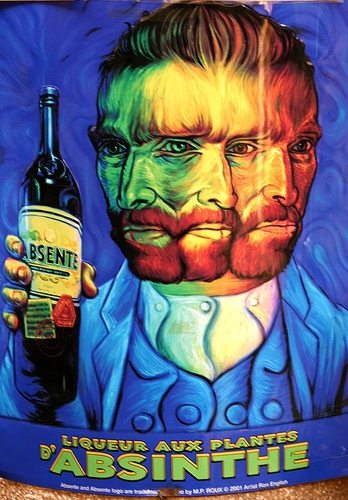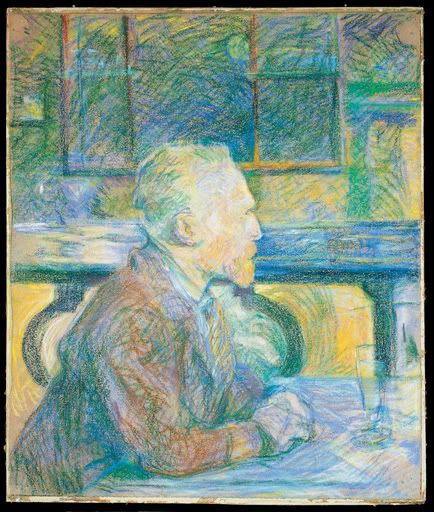Although the Dutch postimpressionist Vincent Van Gogh is now highly acclaimed, he received little recognition in his lifetime. Instead, he lead a difficult life which included depression, bizarre psychiatric symptoms, and finally suicide. Van Gogh’s difficult life –with all its romantic and tragic elements — has been the focus of much medical speculation. His unusual painting style, psychiatric internment, and voluminous correspondence have proven fertile ground for the theories of modern physicians seeking to diagnosis his ailments. Some of these theories have suggested that some kind of drug-induced intoxication was responsible for his painting style and medical symptoms.

Arnold (1988) has argued that Van Gogh’s absinthe drinking played an important role in his illness. In various publications, he (and his colleagues) have suggested that Van Gogh suffered from acute intermittent porphyria (Bonkovsky et al., 1992; Loftus and Arnold, 1991). In this syndrome, a genetic defect in hepatic heme synthesis causes attacks. Symptoms during these attacks can include acute abdominal pain, anxiety, hysteria, delirium, phobias, psychosis, organic disorders, agitation, depression, and altered consciousness from tiredness to coma (Burgovne et al., 1995). Sometimes only one or a few of these symptoms are present during an attack. Attacks can be brought on by nutritional and environmental factors. Van Gogh’s fasting, overworking, malnutrition, and alcohol and absinthe use could have all contributed to triggering attacks.
If Van Gogh did indeed have acute intermittent porphyria, absinthe could have played a particularly significant role. In an in vitro study using chick embryo liver cells, Bonkovsky et al. (1992) have demonstrated that alpha-thujone and some related terpenes are porphyrogenic. In other words, assuming terpenes accumulate to a sufficient extent in the liver, drinking absinthe could trigger attacks in someone with a genetic defect in hepatic heme synthesis. This theory seems particularly compelling because it explains Van Gogh’s symptoms, the age of onset of his problems, the diseases suffered by other family members, and the role of his lifestyle in contributing to his illness.

Arnold (1988) has further suggested that Van Gogh’s fondness for absinthe developed into a generalized craving for thujone and related terpene molecules. Van Gogh is known to have used large amounts of camphor (another terpene) in an attempt to treat insomnia. Furthermore, there are several instances of bizarre behavior which (attempts to eat paint and drink turpentine and kerosene) Arnold sees as evidence for this craving. Although this idea is interesting, there is no strong evidence that terpenes are addictive in this manner. I also wonder if Arnold is not reading too much into Van Gogh’s behavior. Not every action of mentally ill or delirious individuals can be explained, after all. Still, even if Van Gogh were only addicted to the alcohol in absinthe, such an addiction could conceivably have kept Van Gogh see-sawing between alcohol withdrawal and porphyric attacks.
Other authors have focused on Van Gogh’s paintings and whether his illness or drug use might have contributed to his creativity. One theory (Lee 1981) is that the bright yellow hues and character of his later works were the result of digitalis intoxication, which can produce xanthopsia (yellow vision) and coronas (glowing haloes around objects). Although there is no definite record of Van Gogh receiving this drug, it was used as a treatment for epilepsy and Van Gogh twice painted his physician holding a fox glove (Digitalis purpurea) plant, from which digitalis is extracted. Santonin, which is found in low concentrations in Artemisia absinthium and Artemisia pontica, is also known to cause xanthopsia. However, Arnold and Loftus (1991) have determined that the amount of santonin in absinthe would have been insufficient to produce xanthopsia. Santonin therefore cannot be an explanation for Van Gogh’s painting style, while digitalis may have played some role.
In general, I think this type of speculation on the contribution of drugs and illness to art is unproductive. It often seems to rely on an underlying assumption that breaks from ‘realistic’ representation require some explanation other than the artist’s intent. Despite these reservations, I think a case can be made that Van Gogh’s experience with mental illness and absinthe intoxication may have influenced his painting. As Arnold and Loftus (1991) write: …novel experiences of relative sizes, shapes, and colours perceived under the influence of absinthe may have been recalled later and incorporated into new and daring compositions, perspectives, and palettes (p. 507).
Other artists have been known to find inspiration in drug use. However, the connection between creativity and drug intoxication is complex. Drug taking is a social activity. At the same time as an artist is taking a drug, he or she is often interacting with some social group with its own beliefs, behaviors, and aesthetics. When Van Gogh began to drink absinthe, he probably did so in a cafe frequented by writers and artists. It is impossible to separate the artistic influence of that stimulating social environment from whatever effects absinthe could have had on his perception and creativity.
Her you can read about other Famous Artists Who Used Absinthe.





Speak Your Mind